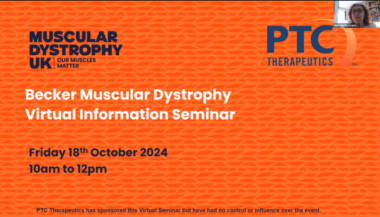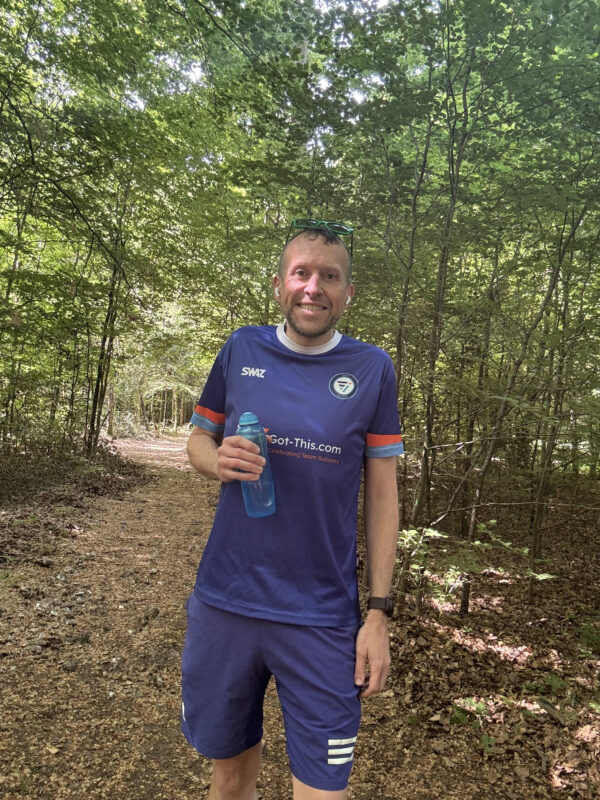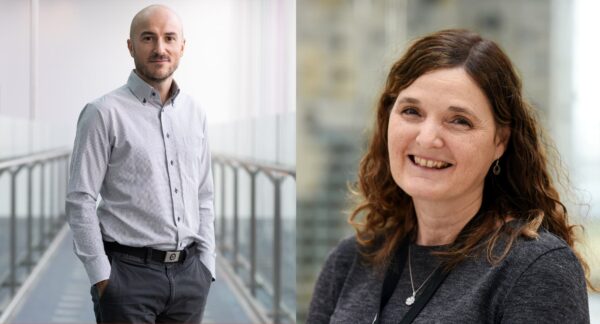Our condition-specific alert cards provide crucial information for emergency healthcare professionals treating patients with muscle wasting conditions.
Becker muscular dystrophy (BMD)
Becker muscular dystrophy (BMD) is a genetic condition that causes slowly progressive muscle weakness, especially around the pelvis and legs. As it advances, it can also affect the heart and lungs.
BMD is related to Duchenne muscular dystrophy (DMD). This is because they are both caused by a change in the dystrophin gene. Symptoms of BMD usually appear later in childhood, are milder than DMD, and don’t typically impact life expectancy.
Symptoms of BMD can vary a lot. While some people may only have mild symptoms, others may have more significant challenges. Diagnosis of BMD is possible from early childhood through to adulthood.
Muscle weakness
Weakness typically begins in the pelvis and legs. This makes it hard to run and play sports. Muscle cramps during exercise can be an early sign of BMD. In rare cases, children may pass dark red or brown coloured urine after exercise. This could be a sign of muscle breakdown (rhabdomyolysis) and needs urgent hospital admission and investigation.
Muscle weakness tends to progress in teenage years and early adulthood. A person may struggle to walk longer distances, climb stairs, or get up from the floor. As the condition progresses, muscle weakness may extend to the shoulders and arms. Lifting heavy objects above waist level and raising the arms above the shoulders can become difficult. By their 40s, 50s, or later, people with BMD may find walking increasingly difficult and they may fall more often. In some cases, they may need to use a wheelchair. In rapidly progressing cases of BMD, needing a wheelchair could happen sooner.
Cardiac
People with BMD can develop heart problems called cardiomyopathy, which makes it harder for the heart to pump blood properly. Cardiomyopathy can happen at any age and symptoms might not show at first. But sometimes it can be the first sign of BMD. Signs to watch out for include feeling out of breath, palpitations, dizziness, and chest pain or tightness. Any of these should be reported to healthcare professionals.
Respiratory
People with BMD can have breathing problems if their breathing muscles are weak. This usually happens at a later stage of the condition or when the person is a wheelchair user. Lung function may be reduced. They might have a weak cough, which can make it harder to clear mucus and other secretions from the airways. This means they are more prone to chest infections and may need treatment for this. Some people may also have breathing problems while sleeping, such as sleep apnoea and nocturnal hypoventilation (shallow breathing at night), which can affect quality of sleep.
Neurodevelopment
Learning difficulties or behavioural conditions like autism, attention deficit hyperactivity disorder (ADHD), obsessive compulsive disorder (OCD), and anxiety can be more common in people with BMD. This is because dystrophin, the same protein missing in the muscles, is also found in the brain. It’s important that these issues are identified early and addressed with appropriate support, such as personalised education health and care plans (EHCP) at school or college, to help children reach their full potential. Adults may need workplace adjustments to support their needs. Specialists may need to be consulted to address specific issues of learning and behaviour, and in some cases, medication is needed.
Genetic changes
BMD is caused by a change in the dystrophin gene. The dystrophin gene provides instructions to make the dystrophin protein. This protein maintains the structure of the muscles. In people with BMD, the body makes some dystrophin, but not enough. This causes muscles to weaken over time because muscle fibres break down.
Duchenne muscular dystrophy (DMD) is a more severe condition caused by a complete lack of dystrophin. DMD usually begins in early childhood and progresses quickly, leading to loss of mobility and serious health problems. In comparison, BMD is generally milder, because the body still makes some dystrophin, so it’s not associated with the severe complications seen in DMD.
Inheritance
BMD is inherited in an X-linked recessive pattern. This means the genetic change causing BMD is located on the X chromosome. Males have only one X chromosome, so they are more likely to be affected by BMD. Females have two X chromosomes, so they are less likely to develop symptoms.
For more information, see our inheritance and genetics page.
Manifesting carriers
Males with BMD are not able to pass on the changed gene to male children, but all their female children will be carriers. Most female carriers do not experience symptoms. However, a small number of carriers can have heart problems or experience muscle weakness later in adult life. When this happens, they are called manifesting carriers of Becker muscular dystrophy.
If signs of a muscle wasting condition are noticed, a GP can refer someone to a neurologist to carry out testing. A neurologist is a doctor who specialises in conditions that affect the muscles and nervous system. The neurologist may come to a diagnosis after using a combination of physical examination, blood tests to measure creatine kinase levels (CK), and genetic testing to look at the dystrophin gene. Sometimes a muscle biopsy is recommended. This is when a small sample of muscle is taken for analysis and to see if dystrophin is being made in the muscle. In some cases, BMD can be diagnosed after finding heart problems with no other muscle symptoms.
For more information, see our diagnosis page.
A multi-disciplinary approach is important in not only managing the condition and symptoms but in improving wellbeing too. BMD affects people differently, with symptoms starting at different ages and varying in severity.
Access to a healthcare team
People with BMD should have access to a multi-disciplinary healthcare team. Usually, the lead professional will be a neurologist. If you don’t have contact with a neurologist or specialist doctor, speak to your GP about getting access to one.
Cardiac
Heart problems are common in BMD, but they can be symptomless. It’s important to have regular heart monitoring appointments with a cardiologist.
Tests may include:
- Electrocardiogram (ECG) – checks the heart’s electrical activity
- Echocardiogram (ECHO) – looks at the heart’s structure and function
- Holter monitoring – records heart rhythms over a period of time
Early treatment of heart problems with drugs called ACE inhibitors and/or beta-blockers can protect the heart muscle and reduce the risk of developing severe cardiomyopathy and heart failure. Shortness of breath, palpitations, dizziness, and chest pain are symptoms that must be reported to healthcare professionals.
Respiratory
Breathing problems can develop in BMD, particularly as limb weakness progresses. At review appointments, doctors may check lung function with forced vital capacity (FVC) testing. Overnight sleep studies may also be needed to check breathing while sleeping. Breathing exercises, cough assist devices, and non-invasive ventilation (NIV) may be recommended to support respiratory function if needed.
Scoliosis
People with BMD may develop scoliosis, where the spine twists and curves to the side because of muscle imbalances. It’s important that the spine is monitored. If needed, a spinal brace may be used to slow the progression of scoliosis. Staying active and continuing to walk can help prevent scoliosis. In some cases, surgery may be needed.
Exercise and physiotherapy
Staying active helps maintain strength and flexibility. A physiotherapist can put together a suitable exercise plan. A physiotherapist is a healthcare professional who helps manage symptoms through movement, exercise, and manual therapy. Regular stretching is recommended to help keep muscles flexible and to prevent tightness across joints. Strengthening exercises will help to slow muscle weakening, and aerobic exercise such as walking, swimming, and cycling can help keep the heart and lungs as healthy as possible. It’s important to allow the body to fully recover after exercise. Some muscle soreness is normal, but severe pain should not happen. For advice for adults, see exercising with a muscle wasting condition.
Steroids
Though steroids (corticosteroids) have been found to slow the progression of Duchenne muscular dystrophy, they are not usually used for BMD. Only in severe cases of BMD will corticosteroids be considered. Steroids have several side effects, which will need to be discussed with a specialist doctor.
Anaesthesia stops a person feeling pain during a procedure or surgery. People with BMD have a higher risk of complications with general anaesthesia. This can be because of heart and breathing issues or adverse reactions to some general anaesthetics. It’s crucial that the anaesthetist and surgical team are aware of a diagnosis of BMD and any cardiac and respiratory complications. A pre-operative assessment and extended post-operative monitoring is necessary. Specialist neuromuscular clinics can be contacted for advice if needed. As every person with BMD is unique, all situations should be assessed individually to provide the safest approach.
Avoid certain anaesthetics, including suxamethonium, inhaled anaesthetics, and neuromuscular blocking drugs. This is due to high risk of acute rhabdomyolysis, which is life-threatening. Rhabdomyolysis is the rapid breakdown of muscles causing muscle pain and dark red or brown coloured urine. If this happens, the individual must be urgently admitted to hospital for treatment.

Author: Muscular Dystrophy UK
Reviewers: Prof Tracey Willis and Dr Maria Elena Farrugia
Last reviewed: February 2025
Next review due: February 2028
Becker muscular dystrophy webinar (2024)
On Friday 18 October 2024 we held a webinar on Becker muscular dystrophy. Watch to learn about the latest research, as well as tips and advice on living well with Becker muscular dystrophy.

We are here for you
Webinars, Information Days, and support groups for our muscle wasting community. Our life-changing support is here for you.
Advice for living with or caring for someone with a muscle wasting condition.


